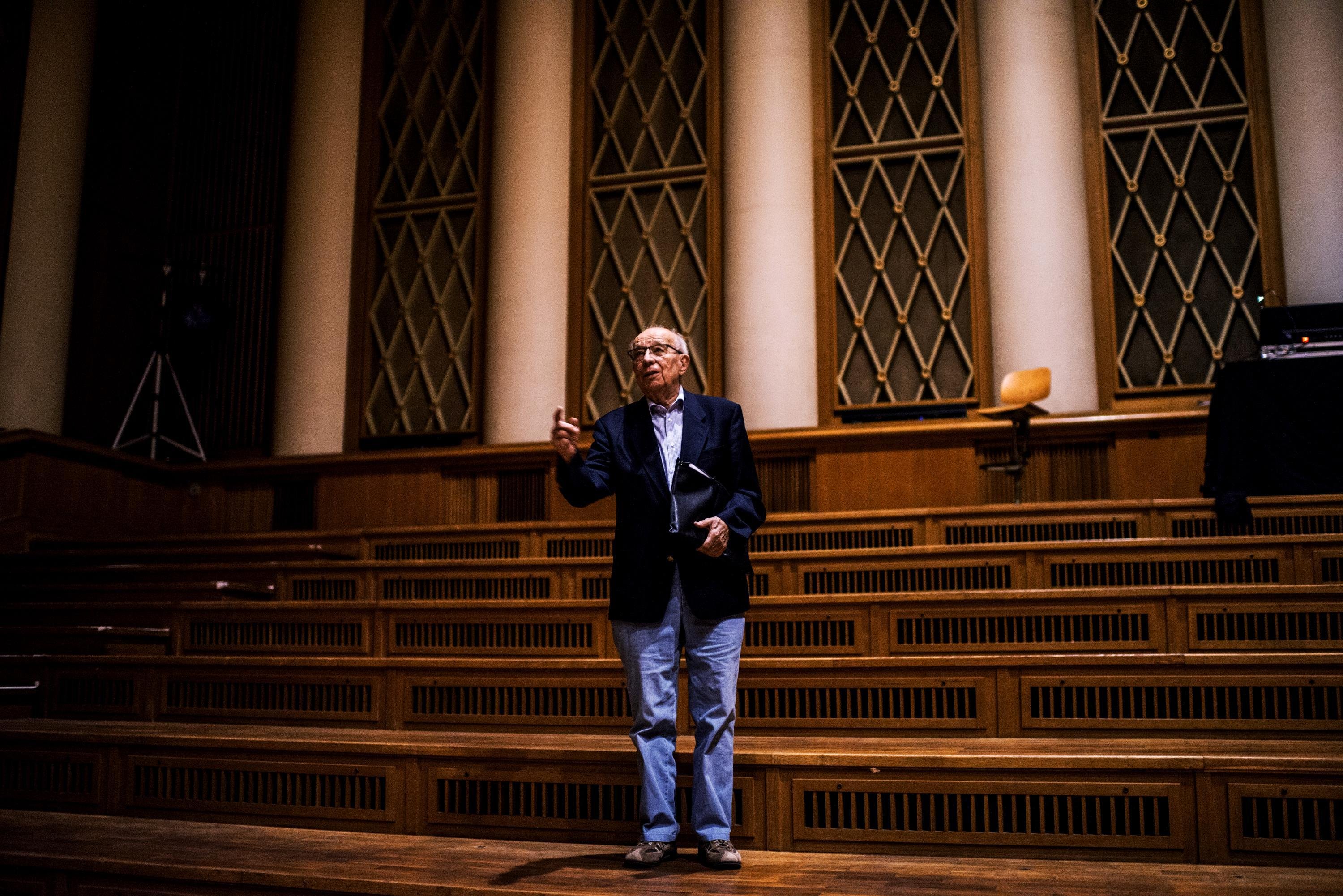Devoted To Perfect Sound: The Life and Career of Gisela Herzog
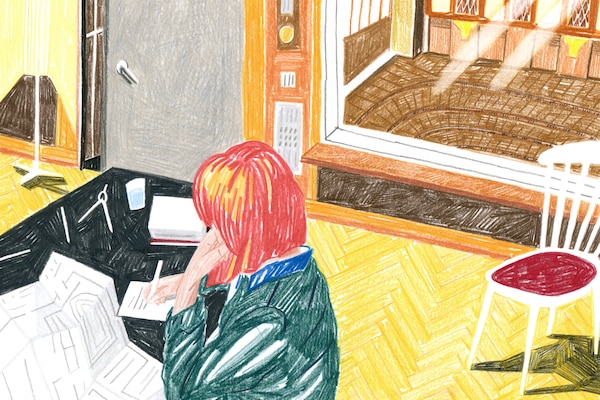
She overcame WWII and gender discrimination to become the best in her field. The resilient sound engineer behind one of the world’s greatest recording studios shares her story
Some people work to live. Others live to work. For Gisela Herzog, her occupation has always been a true calling. A graduate engineer and scholar of applied room and architectural acoustics, she has devoted her life to finding the perfect sound. One of the best in her field, Herzog has built countless concert halls and recording studios all over the former GDR, among them the prestigous Funkhaus Nalepastraße in former East Berlin. It’s a body of work that has the now 92 year old wondering herself, just how did she even do it?
“As I once told my husband: Had I taken all of my extra hours, I could have retired two years earlier,” says Herzog. She’s generally not prone to joking around or exaggeration, and the piercing look from behind her gold-framed glasses leaves no doubt that she is serious here. Herzog is analyst and scientist through and through. Right now, she’s crouched in focus over a low couch table in her living room, browsing through diagrams and graphs in an envelope full of technical reports. Scattered around the table are a bunch of yellowed folders, in which Herzog has filed some of her many papers and published work.
Herzog lives by herself in the East Berlin district of Oberschöneweide, in an apartment that she keeps intact without any outside help. Her husband died years ago, and she does not have children. We first meet at teatime, over strawberry cake that she made earlier that morning. She is a small, lively and mentally switched-on woman – apart from a somewhat stiff walk, one barely notices her age. She’s wearing a high-necked silk blouse with colorful patterns and a pair of cloth pants with a precise accurate crease. Her hair, which has never lost its reddish hue, is cut to a short bob with straight bangs. An old picture, sticking out from two cellophaned newspaper articles, shows that she has stayed loyal to this hair-do for decades.
No one was able to do so, no one had ever done it before. Neither in West Germany.
From a stack of papers, she draws a bound book that she published with her former boss and colleague Gerhard Steinke in 2013. It’s a detailed documentation of the specific room acoustics of the recording facilities and studios at the Funkhaus. The cover sleeve shows a picture of the great Musikaufnahmesaal 1, known to today’s concertgoers as Saal 1: “The room is the music’s gown.”
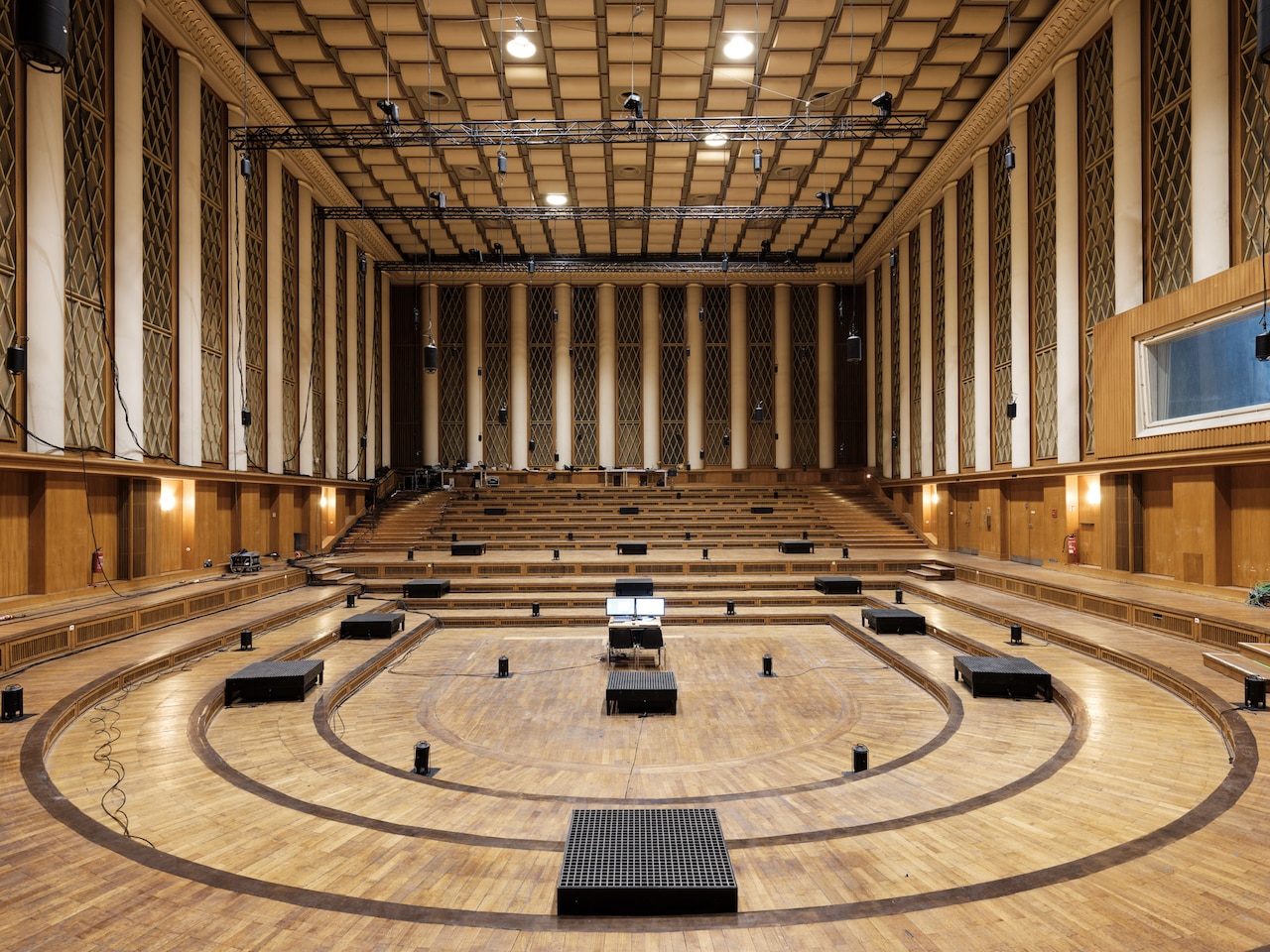
The renovation and reconstruction of the Funkaus in 1951, on the premises of an erstwhile woodworking veneer factory in Oberschöneweide, was the first project that Herzog worked on as an expert and advisor. For the existing rooms in Block A, Herzog made complicated room acoustical calculations and measurements. For the new buildings, such as the studios in Block B, she mapped out the ideal reverberation time, which varies with each musical genre. For this globally unique construction, she mapped out four big music recording rooms and two radio-play complexes containing five studios, each with distinctive room acoustic qualities. She was also in charge of bringing the creative design sketches of the architect Franz Ehrlich to perfect-sounding life.
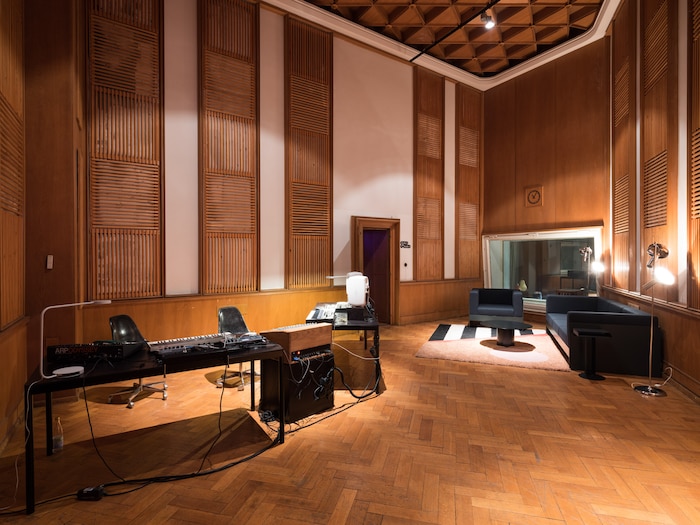
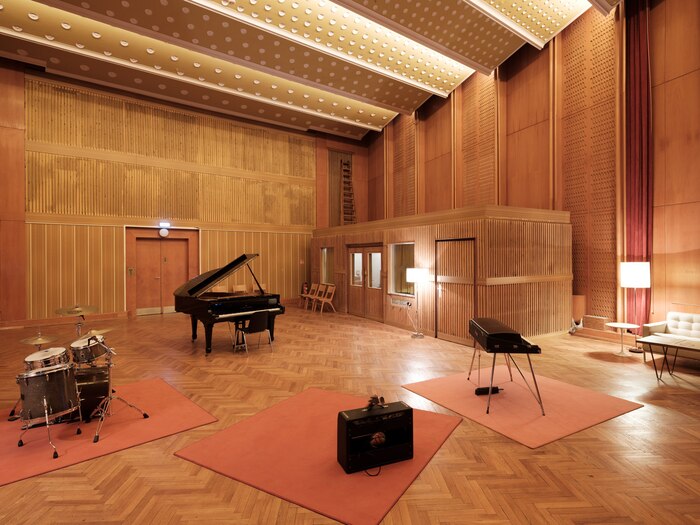
“The architects, they are to be reckoned with. Otherwise they’ll come up with God knows what. The Bourbon Lily in Room 3, for example… Ehrlich was a man of many ideas,” Herzog says about the famous Bauhaus architect, who, as an inmate of the Buchenwald concentration camp, was forced to design the cynical “Jedem das Seine” (“To Each its Own”) entrance sign. As a silent form of protest, Ehrlich crafted this gruesome slogan in the Bauhaus style condemned by the Nazis. It can be read as a subtle act of rebellion that he would use the bourbon lily – the crest of a French noble family – as wall decoration in such a prestigious construction of the still-fledgling, communist GDR. Herzog opens a page with a photo of Saal 3 and casually points to her living room couch: The beige silk cover has the same lily pattern.
“I was responsible for the entire construction of the set-up. How big is the hole, how many lilies per square meter do we need, how thick is the wood? This has to do with the sound permeating and causing cross-resonances. All this I had to compute. Quite a difficult process!“ Despite the fact that these calculations date back almost 70 years, Herzog remembers every tiny detail. Eventually, she admits almost apologetically that she couldn’t do these calculations anymore today. And yet she also knows, “No one was able to do so, no one had ever done it before. Neither in West Germany.”
Just like everything else in post-war Germany, paper was a rare commodity, and so Herzog wrote her letter of resignation to Siemens on a ragged, ripped-off piece.
Born in Potsdam in 1926, Gisela Herzog was part of the “bad generation,“ as she herself puts it. With their men fighting at the frontline, young women got drafted to go to war. The Nazis used them as airforce intelligence and flak support, or threatened them with a “countryside year” in occupied Poland – a propagandistic disciplinary measure of unpaid physical labor. Like many of her peers, Herzog had to leave school without graduating. But due to a string of lucky circumstances and a few good connections, she managed to escape the dangerous war service and instead found work at Siemens, one of the world’s leading electronic companies. There, she underwent a technological education, without, as she says, “losing time because of the war.” The daily commute was arduous – the Berlin district of Siemensstadt was located 30 kilometers away from Herzog’s childhood home in Potsdam. Sometimes, when no trains could travel during bomb scares, she had to walk parts of the route by foot. This attitude still drives her relentless work ethic to this day.
Things became even more complicated once she decided to graduate via night school at the Volkshochschule Berlin. Besides her full-time job at Siemens, Herzog attended 24 lessons weekly, weekends included. “I ran out of the door in Potsdam at 4:30 AM, had to punch in at Siemens at 7, and head over to school in Berlin at night. Mondays, Tuesdays, Thursdays and Fridays I was home by midnight – assuming that I wasn’t stuck at some bunker because of the air raid alerts. And then another six hours of the same on Saturdays and Sundays, I’m telling you…” Her work passport has the abbreviation “uk” for “unabkömmlich,” or “indispensable” – Nazi jargon for “obliged to war service.”
Berlin got bombed heavily during the final years of the war, and thousands were left without a roof over their heads. These included Herzog’s boss, who was bombed out 16 times, and didn’t own more than the clothes he’s wearing and a black briefcase. Still, anyone who tried to flee the city – whether to escape the hunger, the cold or the hail of bombs – and did not give proper notice to their boss about their departure, became wanted and, worst case, might end up in a concentration camp for refusing to work.
The post-war years were likewise marked by hardship, hunger, illness and poverty. As a young and healthy woman, Gisela Herzog belonged to the Trümmerfrauen, or “rubble women,” who had to help clean up and rebuild the city. And yet her daily life had little in common with the glowing women depicted in the staged photos of that era. Every day, all women between 15 and 65 were obliged to show up at the government building to carry out heavy labor assigned to them by Russian officers – for free. Herzog cleared away debris, filled up bomb craters and unscrewed railroad tracks, which were transported to the Soviet Union as reparations.

In the summer of 1945, her erstwhile plant manager tracked Herzog down and brought her back to her former work place at Siemens. By then, there were no more tram connections between Potsdam and Berlin and her daily commute, riding on coal trains to the city, was almost six hours. She worked night shifts week after week, as there was no steady power supply – one week there might only be electricity during the day, and then one where it was only available at night, so factories had to adjust their schedule. “My gross income was 132 Mark, that’s 80 Mark after mobility costs. For that I could buy a kilo of sugar or two kilos of flour on the black market,” Herzog recalls. There was no employee lunch for her either, because her “Ost-Lebensmittelkarte” (“Eastern groceries card”) didn’t apply in the British sector, where her work was located.
Herzog powered through. She was ambitious, describing herself as the “nerdy type” who always tried to be the best at everything. At the age of 22, she was offered the position of laboratory head at Siemens. But since her father could no longer stand witnessing his skinny daughter’s physical stress and poor health condition, he sought out other job options for her. He found an offering in the newspaper: “musically gifted technical assistant wanted.” Qualified employees were rare and Herzog, who played multiple instruments and was technically educated, was in-demand. “I went there in late February, thinking: ’You can just take a look at such a Funkhaus, why not?’ The chief engineer was very old school. He asked me things like ’What is remanence? What is coercivity?’ and so forth. Well, that was my field exactly,” she reminisces with a smile.
I have always gotten things out of the way quickly. There were no idly chattered-away work hours with me.
Just like everything else in post-war Germany, paper was a rare commodity, and so Herzog wrote her letter of resignation to Siemens on a ragged, ripped-off piece. In 1948, she started working as an audio technician and sound engineer at the official broadcasting station of Potsdam. There, she was responsible for the music recordings and transmissions of the in-house orchestra and smaller ensembles, and learned the technological that would serve as the foundation of her later profession.
At the same time, the conflict between East and West was coming to a head. The East German radio stations had to leave the “Haus des Rundfunks” Masurenallee in the British sector of Charlottenburg-Wilmersdorf. Budgets for Herzog’s productions in Potsdam were cut. So she applied for a position in the “Labor für Magnettontechnik,” where they studied analog sound transmission in the central laboratory for music broadcasting and TV in Berlin Adlershof. But their staff acoustician, Dr. Lothar Keibs, had different plans for her, and invitesd Herzog via telegram to join his team.
Keibs’s plans to build an impressive broadcasting complex on the premises of the former factory on the Spree River in Oberschöneweide were still confidential at this point. Until Herzog started working in his laboratory for room and building acoustics in November 1951, she had no idea what was actually going to be built there. But she stayed busy conducting complicated acoustic measurements, writing assessments and thinking up creative sound solutions – such as an acoustically transparent wall cover, made from a paper-thin sliver mesh, that would be used in the recording studios.
Amidst all this work, Herzog chose to continue her education, applying to a university course for engineering alongside 11 male colleagues. All of the men failed the difficult admission exam – but she passed. She began taking classes four nights a week, on top of her 48-hour work week and supporting her mother at home. “I worked literally all day and night. Extra hours were unpaid,” says Herzog. On top of that, she again found herself commuting 50 kilometers every day, from Potsdam through West Berlin to Oberschöneweide, on the wooden benches of a train. And trains to the GDR through West Berlin deliberately had no heating.
It wasn’t only the state that was giving Herzog a hard time at this point: “Men can be spiteful, I can’t even begin to tell you,” she says with a trace of bitterness in her voice. A lot of obstacles were thrown her way, and, so she says, her male peers envied the success of their only female colleague. She worked harder and harder, managing the workload of two people, and even took work home with her. At one point, she was sent away on a three-week health leave, only to continue working the whole time. And although she was working for Keibs, finishing broadcasting houses all over the GDR, her wages were only a fraction of his paycheck. “I got exploited by him,” she says today.
Because she refused to become a member of the SED party (“Sozialistische Einheitspartei Deutschlands”), Herzog encountered politically motivated acts of sabotage as well. When it came to annual bonus payments, she received the lowest amount. One of her supervisors, an SED member, argued that she had to be punished for her “hectic work style.” “I have always gotten things out of the way quickly. There were no idly chattered-away work hours with me,” Herzog claims. Only once did she overhear her supervisor say to an architect that “Herzog equals quality.” “Just this one time,” she stresses.
Eventually, Herzog’s work brought her numerous times to various socialist foreign countries, including Moscow, Posen, Prague and Sofia, and she ended up building broadcasting studios in all 14 district capitals of the former GDR. However, it’s the Funkhaus Nalepastr. in Berlin that she is most proud of. Back at home, she presents a newspaper article from 2004, depicting a younger Daniel Barenboim. The Argentinian-Israeli pianist and internationally renowned star conductor once visited the Funkhaus with a producer of the Beatles. In this article, Barenboim describes Saal 1 as one of the best recording studios in the entire world. “You see, I did not make that up!” says Herzog, holding the article like a piece of evidence.
It is this kind of acclaim that compensates her for a life full of work and hardship. She wouldn’t have had it any other way. “I have done all of this with so much passion and love,” Herzog concludes. “This work was tailor made for me.”
Translation by Julian Brimmers
Header image © Julia Krusch
